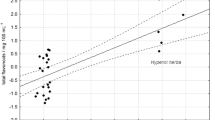The aim of the experiments was to study features of the extraction of rare-earth elements from medicinal plant raw materials (MPM) into infusions and decoctions. The pharmacopoeial types of medicinal plant raw material used in the work were nettle leaves (Urtica dioica L.), plantain leaves (Plantago major L.), tansy flowers (Tanacetum vulgare L.), linden flowers (Tilia cordata Mill.), motherwort herb (Leonurus quinquelobatus Gilib.), absinthe herb (Artemisia absinthium L.), yarrow herb (Achillea millefolium L.), knotweed (Polygonum aviculare L.), burdock roots (Arctium lappa L.), and dandelion roots (Taraxacum officinale F. H. Wigg). The microelement composition of the samples was studied by mass spectroscopy after acidic and microwave decomposition. Lanthanides were contained least in plant flowers (0.08 – 0.22 μg/g). The highest lanthanide concentrations were observed in roots of the plants, in knotgrass, and in plantain leaves (1.20 – 2.41 μg/g). The lanthanide contents in infusions and decoctions prepared from the MPMs varied from 0.0001 to 0.0168 μg/mL. The relative concentration of lanthanides in the calculated mineral complex of the manufactured medicinal herbal products was ≤0.0005%; in most cases, <0.0001%. The dependence of the lanthanide contents in infusions and decoctions on their contents in the medicinal plants showed that their concentrations in the aqueous extracts increased as the concentrations of all determined elements increased. However, the degree of extraction of the lanthanides into the aqueous extracts decreased as their contents in the MPM increased.






Similar content being viewed by others
References
N. A. D’yakova, Tr. Karel. Nauchn. Tsentra Ross. Akad. Nauk, No. 5, 70 – 79 (2020).
N. A. D’yakova, A. I. Slivkin, and S. P. Gaponov, Khim.-farm. Zh., 54(6), 68 – 72 (2020); Pharm. Chem. J., 54(6), 626 – 630 (2020).
N. A. D’yakova, A. I. Slivkin, E. E. Chupandina, and S. P. Gaponov, Khim. Rastit. Syr’ya, No. 4, 5 – 13 (2020).
N. A. D’yakova, Biofarm. Zh., 14(4), 3 – 11 (2022).
A. A. Gudkova, A. S. Chistyakova, A. I. Slivkin, and A. A. Sorokina, Mikroelem. Med., No. 1, 35 – 42 (2019).
M. A. Rudaya, O. V. Trineeva, and A. I. Slivkin, Mikroelem. Med., No. 3, 49 – 59 (2018).
A. I. Popov, Vopr. Pitan., No. 2, 38 – 39 (1994).
C. H. Hill and G. Matrone, Fed. Proc., 29(4), 1474 – 1481 (1970).
J. Li and S. M. Assmann, Plant Physiol., 123, 807 – 809 (2000).
O. Wada and H. Yanagisawa, Med. Drug J., 12, 126 – 134 (1997).
O. A. Kolosova and O. V. Trineeva, Mikroelem. Med., No. 1, 54 – 66 (2022).
A. P. Avtsyn, A. A. Zhavoronkov, M. A. Rish, and L. S. Strochkova, Microelements of Man: Etiology, Classification, Organopathy [in Russian], Meditsina, Moscow (1991).
A. V. Skal’nyi, Microelements: Vigor, Health, Longevity [in Russian], Pero, Moscow (2019).
A. V. Skal’nyi, M. G. Skal’naya, A. A. Kirichuk, and A. A. Tin’kov, Medicinal Elementology [in Russian], Nauka, Moscow (2021).
A. D. Kotelnikova, O. B. Rogova, and V. V. Stolbova, Eurasian Soil Sci., 54(1), 117 – 134 (2021).
I. V. Gravel’, D. V. Levushkin, I. V. Mikheev, and A. A. Skibina, Tradits. Med., No. 66, 19 – 26 (2021).
I. V. Gravel’, T. N. K. Nguen, N. A. Alekseeva, and O. A. Tarasenko, Farmatsiya, No. 3, 24 – 27 (2013).
I. V. Gravel’, N. V. Ivashchenko, and I. A. Semylina, Farmatsiya, No. 1, 9 – 11 (2011).
V. A. Kurkin, Pharmacognosy [in Russian], SamGMU, Samara (2004), pp. 473 – 476.
State Pharmacopoeia of the Russian Federation, XIVth Ed., Vol. 4, FEMB, Moscow (2018).
Author information
Authors and Affiliations
Corresponding author
Additional information
Translated from Khimiko-Farmatsevticheskii Zhurnal, Vol. 57, No. 5, pp. 44 – 49, May, 2023
Rights and permissions
Springer Nature or its licensor (e.g. a society or other partner) holds exclusive rights to this article under a publishing agreement with the author(s) or other rightsholder(s); author self-archiving of the accepted manuscript version of this article is solely governed by the terms of such publishing agreement and applicable law.
About this article
Cite this article
Dyakova, N.A. Features of Extraction of Rare-Earth Elements from Medicinal Plant Raw Materials Into Infusions and Decoctions. Pharm Chem J 57, 688–693 (2023). https://doi.org/10.1007/s11094-023-02939-5
Received:
Published:
Issue Date:
DOI: https://doi.org/10.1007/s11094-023-02939-5




